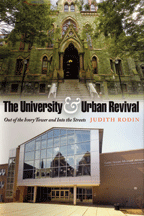
THE UNIVERSITY AND URBAN REVIVAL:
Out of the Ivory Tower and Into the Streets
Judith Rodin CW’66 Hon’04. University of Pennsylvania Press, 2007. $34.95.
The revitalization of University City and Penn’s West Philadelphia neighborhood in recent years has not gone unnoticed, either in the Gazette or in other publications, but The University and Urban Revival has one thing going for it that sets it apart from other accounts—it was written by one Judith Rodin, Penn’s president from 1994-2004 and the principal architect of that transformation. Published as part of the Penn Press series on The City in the 21st Century, the book is the ultimate insider account—at times exhausting in its detail but ultimately uplifting—of one of the most significant moments in the University’s development, both on its own merits and in the way it has contributed to Penn’s overall advance in prestige and popularity.
President Emerita Rodin, who now heads the Rockefeller Foundation, would likely have taken a special interest in “town-gown” relations anyway—she grew up in Philadelphia, attending public schools, and when she began her presidency a fellow alumnus named Ed Rendell C’65 Hon’00 was the city’s mayor—but the issue really hit home in the fall of 1996, when a surge of crimes culminated in the murder of Penn biochemist Vladimir Sled, a 38-year-old Russian émigré, on October 31.
“With the events of that Halloween night—a random act of violence in a neighborhood that had become increasingly rife with crime,” Rodin writes in the book’s prologue, “I knew that the time for unprecedented action had arrived.”
That action would take many forms, from a variety of “clean and safe” initiatives to make the neighborhood more inviting, to increased incentives for home ownership and investments in commercial developments, to partnering with the teachers’ union and school district to build a new neighborhood elementary school. Among many laudatory assessments, the Chronicle of Higher Education called Penn’s efforts a “national model of constructive town-gown interaction and partnership.”
Not that things went smoothly at all times. In many ways, the Penn Alexander School, which opened in 2001, was the most contentious project of all to get off the ground—a considerable surprise to its proponents, who, Rodin recounts, “were certain that their neighbors would cheer this project because, after all, what was not to like?” Instead, “As we would soon find out, there was at least one complaint for just about everything.” And it is instructive to recall, as work proceeds on developer-financed retail and residential projects from the former postal lands to 40th Street (see this issue’s “Gazetteer”), that the University had to finance the retail and hotel complex known as Sansom Common at 36th and Walnut streets with its own money, and that The Bridge movie theater at 40th and Walnut stood unfinished for more than a year after original partner Robert Redford pulled out, again requiring University investment to complete. There were plenty of skeptics—and moments of doubt even among sympathizers—along the way.
Early on, Rodin describes her own consciousness-raising on urban issues as a graduate student at Columbia University and during her years at Yale, and sketches in the University’s often-troubled history with its neighbors. (She gives credit to some early steps at rapprochement taken during the tenure of former Penn President Sheldon Hackney Hon’93.)
The bulk of the book is organized around chapters devoted to the major West Philadelphia initiatives. Each is accompanied by a wealth of statistics, charts, and other supporting data—which, however, never quite overwhelm the sense of excitement and pride Rodin communicates about managing to harness the unwieldy tools of government, private business, community groups, and academe to effect significant positive change in a place she loves.
Rodin opens the book with a childhood memory of the close-knit neighborhood she knew growing up at 59th and Windsor, where “we had enough kids on our street for a baseball game.” Having spent her later years going to bat for today’s students, families, and neighbors by helping to remake the area, she closes with an observation: “I had the great privilege of leading the University of Pennsylvania, my alma mater, in the city where my parents spent their lives and where I was raised. And each time I return to University City, as I often do, it is a thrill to experience its vibrancy and to know I had a part in the transformation. As I said about that baseball team of neighborhood kids I was lucky enough to have on the street where I grew up, it does not get any better than that.”
—J.P.




